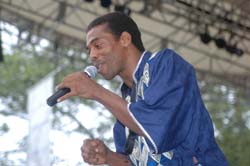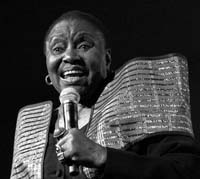
Modern Popular Music
Regional Differences
Our exploration of the African world of music would be incomplete without a discussion of modern popular music, a relatively new musical idiom that developed in the early part of the last century. As explained at the beginning of this chapter, most African territories were colonized by European countries. The introduction of European music, notably through the Christian church, was to have a lasting effect on the musical traditions of the continent.
In responding to the cultural challenge that came with colonialism, African musicians, rather than copy Western musical styles, incorporated them within their own indigenous traditions to generate a new musical synthesis. This creative engagement has resulted in the development of new musical styles strongly rooted in indigenous traditions, in spite of the Western influences they reflect. These new syncretic idioms vary from one region to another.
One of the most important examples in North Africa is rai, a musical idiom that is very popular in Algeria. In the first two decades of the twentieth century, rai was rooted in Arabic love poetry and was performed by women at gatherings as well as in cafes and bars. In the 1950s and 60s, musical instruments like the violin, lute, and trumpet were added by Bellemou Messaoud, the most important performer of rai at the time. In the 1980s, rai became heavily influenced by American pop music resulting in a form that departed from its original Bedouin origins. Drum machines, guitars and synthesizers became part of the instrumental resources of the genre. Rai has since become a popular international African idiom, especially through the songs of musicians like Cheb Mami, Cheba Fadela, and Cheb Sahraoui, all of whom now reside in France.
By the late 1950s, highlife music had become the dominant popular music idiom in many West African countries, including Ghana, Nigeria and Sierra Leone. In southern Africa, the two most important popular forms are the chimurenge music of Zimbabwe and the mbaqanga of South Africa. These two styles were closely associated with the struggle for independence and majority rule in these two countries. Chimurenga, which also combines traditional songs and rhythms with Western instruments, was used by members of the liberation groups in Zimbabwe to mobilize an African resistance against white minority rule. Similarly the mbaqanga, in its use of Western instruments, jazz idioms and traditional rhythms, was closely connected with twentieth century political and cultural history of South Africa, defined largely by the imposition of apartheid and how the racist policy was resisted by South Africans (see Discover Video).
By far the most widely patronized popular music in Africa is the Congolese rumba or soukous (see Discover Video). Although originating in Central Africa, this music is now enjoyed in every region of the continent. Some of the features of this music are:
- Multi-layered guitar ostinato patterns, which are evocative of African drumming styles.
- The use of lyrics in indigenous language, especially Lingala, and/or the imposed colonial French language.
- The prominence of instrumental sections, known as the seben, noted for heightened drumming and pulsating guitar improvisations.
- An expressive singing style that is hard to miss.
- A very strong element of dance, especially in the seben section.
All these features are illustrated in a song titled "Amie Mamibo" by a band known as Zaiko Langa Langa (from Rough Guide to Congolese Soukous, World Music Network, London).
Composer: 0
-
"Zaiko Langa Langa - Amie Mamibo"
Conclusion
We have discussed several musical traditions guided by the need to understand them within the context of African history and culture. For although musical traditions in Africa, as elsewhere, have an inherent entertainment value, the importance of music often derives significantly from its utilitarian value in various communities. We have, for example, seen the role that music plays within the religious belief system of the Shona people of Zimbabwe, and explored the role of music within the initiation rites of the Mende people of Sierra Leone. In this regard therefore, African music provides the window through which we develop a good understanding of the diverse peoples and cultures of the continent. African musical traditions are marked by an almost infinite variety of resources and styles. This element of variety is conditioned by the forces of history and the peculiar nature of each region, country, and ethnicity. We have seen, however, that in spite of the pervading element of variety, there are significant cross-cultural similarities which unite the different regions and peoples of the continent.





The Vai have professional musicians--both men (manja) and women (kengai)--who receive training in the secret societies and provide music for social activities and events.







